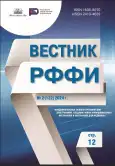Complexes of Sn(IV), Sb(V) with Redox-Active Ligands as Mediators of Electrochemical Transformations of Alkanthiols
- Authors: Shinkar’ E.V.1, Galustyan A.V.1, Tishkov A.A.1, Fokin V.A.1, Berberova N.T.1, Smolyaninov I.V.1
-
Affiliations:
- Astrakhan State Technical University
- Issue: Vol 122, No 2 (2024): THEMED SECTION: FUNDAMENTAL PRINCIPLES OF ORGANIC ELECTROCHEMISTRY, CREATION OF NEW FUNCTIONAL MATERIALS AND MATERIALS FOR MEDICINE
- Pages: 48-57
- Section: THEMED SECTION: FUNDAMENTAL SCIENTIFIC RESEARCH IN THE FIELD OF NATURAL SCIENCES
- URL: https://journal-vniispk.ru/1605-8070/article/view/303437
- DOI: https://doi.org/10.22204/2410-4639-2024-122-02-48-57
- ID: 303437
Cite item
Full Text
Abstract
It is proposed to use complexes of antimony (V), tin (IV) with a tridentate O,N,O'-donor ligand as electromediators for the oxidation of C4, C6 alkanethiols to disulfides and in reactions with 1-hexene, bromocyclopentane aimed at producing sulfides at room temperature. In the presence of Sb (V), Sn (IV) complexes, alkanethiols were subjected to oxidative or reductive activation in solution, which made it possible to reduce the overvoltage of electrode processes compared to heterogeneous electron transfer. The [(p-FC6H5)3Sb(Cat-N-Cat)] complex showed high activity in the electrocatalytic transformations of alkanethiols into disulfides. This complex also turned out to be effective in the synthesis of sulfides based on alkanethiols of various structures and 1-hexene. The interaction of alkanethiols with bromocyclopentane with the participation of the mediator [Ph2Sn(Cat-N-SQ)] leads to the formation of unsymmetrical sulfides along with disulfides of symmetrical structure. The involvement of Sb(V), Sn(IV) complexes with a redox-active ligand in mediator electrosynthesis turned out to be appropriate due to its energy efficiency and environmental safety in comparison with direct electrochemical methods for the production of mono- and disulfides.
About the authors
Elena V. Shinkar’
Astrakhan State Technical University
Author for correspondence.
Email: berberova@astu.org
Russian Federation, 16/1 Tatishcheva Str., Astrakhan, 414056, Russia
Andrey V. Galustyan
Astrakhan State Technical University
Email: galustyan_1997@mail.ru
Russian Federation, 16/1 Tatishcheva Str., Astrakhan, 414056, Russia
Alexander A. Tishkov
Astrakhan State Technical University
Email: shura.tishkov.2000@mail.ru
Russian Federation, 16/1 Tatishcheva Str., Astrakhan, 414056, Russia
Vasiliy A. Fokin
Astrakhan State Technical University
Email: fokin.vasilii008@bk.ru
Russian Federation, 16/1 Tatishcheva Str., Astrakhan, 414056, Russia
Nadezhda T. Berberova
Astrakhan State Technical University
Email: nberberova@gmail.com
Professor
Russian Federation, 16/1 Tatishcheva Str., Astrakhan, 414056, RussiaIvan V. Smolyaninov
Astrakhan State Technical University
Email: ivsmolyaninov@gmail.com
Russian Federation, 16/1 Tatishcheva Str., Astrakhan, 414056, Russia
References
- H. Tanaka, M. Kuroboshi, K. Mitsudo Electrochem., 2009, 77(12), 1002. doi: 10.5796/electrochemistry.77.1002.
- V. Cadierno Catalysts, 2021, 11(5), 646. doi: 10.3390/catal11050646.
- C. Ma, P. Fang, Z.-R. Liu, S.-S. Xu, K. Xu, X. Cheng, A. Lei, H.-C. Xu, C. Zeng, T.-S. Mei Sci. Bull., 2021, 66(23), 2412. doi: 10.1016/j.scib.2021.07.011.
- D.A. Burmistrova, I.V. Smolyaninov, N.T. Berberova Chimica Techno Acta, 2023, 10(4), №202310418. doi: 10.15826/chimtech.2023.10.4.18.
- Yu.G. Budnikova Modern Organic Electrosynthesis. Principles, Research Methods and Practical Applications. Monograph [Sovremenny organichesky elektrosintez. Printsipy, metody issledovania i prakticheskie prilozhenia. Monografia], RF, Moscow, INFRA-M, 2016, 440 pp. (in Russian).
- U.M. Dzhemilev Chem. Sustain. Dev., 2008, 16, 621.
- N. Selander, K.J. Szabó Chem. Rev., 2011, 111(3), 2048. doi: 10.1021/cr1002112.
- B.D. Matson, E.A. McLoughlin, K.C. Armstrong, R.M. Waymouth, R. Sarangi Inorg. Chem., 2019, 58(11), 7453. doi: 10.1021/acs.inorgchem.9b00652.
- S.A. Cook, J.A. Bogart, N. Levi, A.C. Weitz, C. Moore, A.L. Rheingold, J.W. Ziller, M.P. Hendrich, A.S. Borovik Chem. Sci., 2018, 9(31), 6540. doi: 10.1039/c7sc05445a.
- A. Nakada, T. Matsumoto, H.-C. Chang Coord. Chem. Rev., 2022, 473, 214804. doi: 10.1016/j.ccr.2022.214804.
- E.V. Shinkar', I.V. Smolyaninov, N.T. Berberova Russ. J. Coord. Chem., 2023, 49(Suppl. 2), S128. doi: 10.1134/S107032842360122X.
- N.T. Berberova, E.V. Shinkar', I.V. Smolyaninov, A.V. Shvetsova, D.B. Sediki Russ. J. Coord. Chem., 2017, 43(9), 540 (in Russian). doi: 10.7868/S0132344X17070039.
- V.A. Lavrentiev, E.V. Shinkar', I.V. Smolyaninov, Yu.I. Ryabukhin, N.T. Berberova Russ. J. Coord. Chem., 2021, 47(5) 300 (in Russian). doi: 10.31857/S0132344X21050030.
- A.V. Piskunov, O.Yu. Sukhoshkina, I.V. Smolyaninov Russ. J. Gen. Chem., 2010, 80(4), 790. doi: 10.1134/S1070363210040195.
- I.V. Smolyaninov, A.I. Poddel'sky, S.A. Smolyaninova, N.T. Berberova Russ. J. Coord. Chem., 2014, 40(10), 608 (in Russian). doi: 10.7868/S0132344X14090096.
- A.I. Poddel'sky, N.N. Somov, Yu.A. Kurskii, V.K. Cherkasov, G.A. Abakumov J. Organomet. Chem., 2008, 693(21-22), 3451. doi: 10.1016/j.jorganchem.2008.08.002.
- A.J. Gordon, R.A. Ford The Chemist’s Companion: a Handbook of Practical Data, Techniques, and References, USA, NY, New York, John Wiley & Sons, Inc., 1972, 560 pp.
- Handbuch der Präparativen Anorganischen Chemie (in drei Bänden), herausg. von G. Brauer, DDR, Stuttgart, Ferdinand Enke Verlag, 1978–1981.
Supplementary files








